Related Research Articles

Yahgan or Yagán, is an extinct language that is one of the indigenous languages of Tierra del Fuego, spoken by the Yahgan people. It is regarded as a language isolate, although some linguists have attempted to relate it to Kawésqar and Chono.
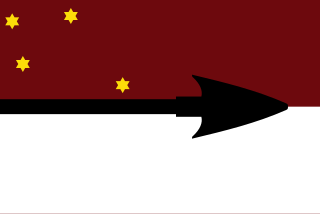
The Selk'nam, also known as the Onawo or Ona people, are an indigenous people in the Patagonian region of southern Argentina and Chile, including the Tierra del Fuego islands. They were one of the last native groups in South America to be encountered by migrant Europeans in the late 19th century. In the mid-19th century, there were about 4,000 Selk'nam; by 1919 there were 297, and by 1930 just over 100.

The Chonan languages are a family of indigenous American languages which were spoken in Tierra del Fuego and Patagonia. Two Chon languages are well attested: Selk'nam, spoken by the people of the same name who occupied territory in the northeast of Tierra del Fuego; and Tehuelche spoken by the people of the same name who occupied territory north of Tierra del Fuego. The name 'Chon', or Tshon, is a blend of 'Tehuelche' and 'Ona'.

The Yahgan are a group of indigenous peoples in the Southern Cone of South America. Their traditional territory includes the islands south of Isla Grande de Tierra del Fuego, extending their presence into Cape Horn, making them the world's southernmost human population.
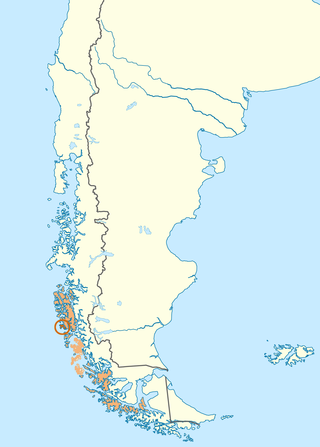
Kawésqar (Qawasqar), also known as Alacaluf, is a critically endangered Alacalufan language spoken in southern Chile by the Kawésqar people. Originally part of a small family, only the northern language remains. In 2009, only a handful of elderly people spoke the language, most of whom lived on Wellington Island off the southwest coast of Chile.
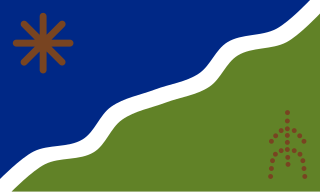
The Kawésqar, also known as the Kaweskar, Alacaluf, Alacalufe or Halakwulup, are an indigenous people who live in Chilean Patagonia, specifically in the Brunswick Peninsula, and Wellington, Santa Inés, and Desolación islands northwest of the Strait of Magellan and south of the Gulf of Penas. Their traditional language is known as Kawésqar; it is endangered as few native speakers survive.

Anne MacKaye Chapman was a Franco-American ethnologist who focused on the people of Mesoamerica writing several books, co-producing movies, and capturing sound recordings of rare languages from the Northern Triangle of Central America to Cape Horn in South America.
Esteban Lucas Bridges was an Anglo-Argentine author, explorer, and rancher. After fighting for the British during the First World War, he married and moved with his wife to South Africa, where they developed a ranch with her brother.
Ona, also known as Selk'nam (Shelknam), is a language spoken by the Selk'nam people in Isla Grande de Tierra del Fuego in southernmost South America.

Fuegians are the indigenous inhabitants of Tierra del Fuego, at the southern tip of South America.

Spanish is the de facto official and administrative language of Chile. It is spoken by 99.3% of the population in the form of Chilean Spanish, as well as Andean Spanish. Spanish in Chile is also referred to as "castellano". Although an officially recognized Hispanic language does not exist at the governmental level, the Constitution itself, as well as all official documents, are written in this language.
Puelche was a language formerly spoken by the Puelche people in the Pampas region of Argentina. The language is also known as Gününa Küne, Gennaken (Guenaken), Northern Tehuelche, Gününa Yajich, Ranquelche, and Pampa.

Tehuelche is one of the Chonan languages of Patagonia. Its speakers were nomadic hunters who occupied territory in present-day Chile, north of Tierra del Fuego and south of the Mapuche people. It is also known as Aonikenk or Aonekko 'a'ien.
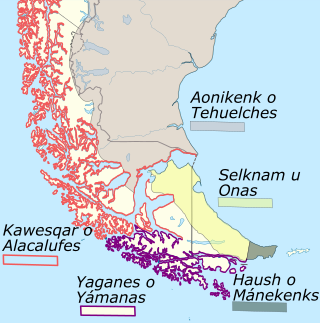
The Haush or Manek'enk were an indigenous people who lived on the Mitre Peninsula of the Isla Grande de Tierra del Fuego. They were related culturally and linguistically to the Selk'nam people who also lived on the Isla Grande de Tierra del Fuego, and to the Tehuelche people of southern mainland Patagonia.
The Teushen language is an indigenous language of Argentina, which may be extinct. It was spoken by the Teushen people, a nomadic hunter-gatherer people of Patagonia, who lived between the Puelche people to their north and the Tehuelche people to the south, who occupied the central part of the Tierra del Fuego region. The tribe is now extinct.
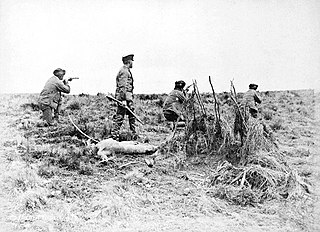
The Selk'nam genocide refers to the systematic extermination of the Selk'nam or Ona people, one of three indigenous tribes populating Tierra del Fuego in South America, from the second half of the 19th to the early 20th century. The genocide spanned a period of between ten and fifteen years. The Selk'nam had an estimated population of 4,000 people around the 1880s but saw their numbers reduced to 500 by the early 1900s.
The Haush language was an indigenous language spoken by the Haush people and was formerly spoken on the island of Tierra del Fuego. The Haush were considered the oldest inhabitants of Tierra del Fuego; they inhabited the far eastern tip of the Mitre Peninsula. They made regular hunting trips to Isla de los Estados.

Thomas Bridges was an Anglican missionary and linguist, the first to set up a successful mission to the indigenous peoples in Tierra del Fuego, an archipelago shared by Argentina and Chile. Adopted and raised in England by George Pakenham Despard, he accompanied his father to Chile with the Patagonian Missionary Society. After an attack by indigenous people, in 1869 Bridges' father, Despard, left the mission at Keppel Island of the Falkland Islands, to return with his family to England. At the age of 17, Bridges stayed with the mission as its new superintendent. In the late 1860s, he worked to set up a mission at what is now the town of Ushuaia along the southern shore of Tierra del Fuego Island.

The Fuegian dog, or Yahgan dog, is an extinct type of canid. In comparison to the domestic dog’s ancient wolf ancestry, the Fuegian dog was bred and domesticated from the South American culpeo, also known as the culpeo fox. The culpeo itself is similar to true foxes, though it is closer, genetically, to wolves, coyotes and jackals ; thus it is placed in a separate genus within the South American foxes or zorros.
References
- ↑ Yámana at Ethnologue (25th ed., 2022)

- ↑ Qawasqar at Ethnologue (25th ed., 2022)

- ↑ Ona at Ethnologue (25th ed., 2022)

- Adelaar, Willem. The Languages of the Andes. Cambridge: Cambridge University Press, 2004. Print.
- Aguilera, Oscar. “Fuegian Languages.” The Vanishing Languages of the Pacific Rim. Ed. Osahito Miyaoka, Osamu Sakiyama, Michael E. Krauss. New York: Oxford University Press, 2007. 206 – 218. Print.
- Campbell, Lyle, and Verónica Grondona, eds. The Indigenous Languages of South America: A Comprehensive Guide. Berlin: Walter de Gruyter GmbH & Co. KG, 2012. Print.
- “Family Chon.” The World Atlas of Language Structures Online. n.d. Web. 22 Apr. 2014.
- “Language Qawasqar.” The World Atlas of Language Structures Online. n.d. Web. 20 Apr. 2014.
- “Language Selknam.” The World Atlas of Language Structures Online. n.d. Web. 20 Apr. 2014.
- “Language Yahgan.” The World Atlas of Language Structures Online. n.d. Web. 20 Apr. 2014.